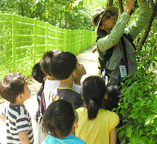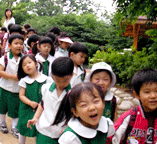Mountain / Park
Welcome to Dongdaemun-gu
Mt. Baebong (Mt. Baebong Green Park)
It is located across Jeonnong-dong and Hwigyeong-dong in-dongdaemun-gu. Baebongsan, located in the back of the University of Seoul campus, rises up to 108 meters above the sea level, making it a popular spot for hiking. Baebongsan is a historic place that provides a great opportunity for tourists to have a complete view.


Jungnangcheon (Jungnangcheon Sports Park)
Jungnangcheon, the first tributary of the Han River, originates from a valley in the north of Suraksan, located in San-gok-dong, Yangju, Gyeonggi-do. It passes through the middle-ground between-dobongsan (716m) and Suraksan (637m) to combine with Uicheon, originating from Bukhansan (836m). Then it combines with Cheonggyecheon in the downstream and finally joins the mainstream of the Han River. It is 36.5km in length and 8.61km wide on average, and accompanies a total of 13 tributaries, including Cheonggyecheon and Uicheon.
The Origin of Jungnangchon
The riverside along Jungnangcheon is home to athletic parks. Blessed with a refreshing natural environment, Jungnangcheon is an ideal place around which to take a walk or play various sports.
- Athletic Park 1: in front of Jangpyeong Neighborhood Park in Jangan-dong
- Athletic Park 2: in front of Samsung Raemian Apt. Complex in Jangan-dong
- Athletic Park 3: in front of the Police Forensic Research Institute in Hwigyeong-dong
- Athletic Park 4: near the central railway in Hwigyeong-dong
- Athletic Park 5: in front of Daewoo Apt. Complex in Imun-dong (upstream area near Ihwagyo(Bridge))
- ☎ 2127-4842 · Main facilities include: a bicycle track (5.6km long), a basketball court, a badminton court, a jokgu court, a roller-blade track, etc.
Cheonggyecheon
Cheonggyecheon, the second tributary of the Han River, originates from Inwangsan, flows around the central part of Seoul to the east, and joins with Jungnangcheon, the first tributary of the Han River, in the border area between Sageun-dong, Songjeong-dong, and Seongsu-dong.It is 13.7 kilometers long. The Cheonggyecheon Restoration Project waged by the municipal government of Seoul began in July, 2003, and ended on October 1, 2005, opening it up as a refreshing site in the middle of the city. The downstream of Cheonggyecheon passes through-dongdaemun-gu. A variety of fish and aquatic plants is found in the downstream Cheonggyecheon, providing sightseeing opportunities for passersby and tourists in the area.
The Origin of Cheonggyecheon
Cheonggyecheon serves to gather the water within the Seoul basin and flows from west to east. It used to be colloquially referred to as ‘Gaecheon’ or ‘Cheongpunggyecheon’. ‘Gaecheon’, or ‘an open streamlet’, refers to the stream and river arrangement works carried out under the reign of King Taejong in the early Joseon Dynasty. In the thirty-sixth year (1760) of King Yeongjo’s reign, 200,000 laborers were mobilized to dig a hole in the area and get rid of the sand for fifty-seven days, literally ‘opening up’ a streamlet. Some sources of history claim that the stream had been called ‘Gaecheon’ since the reign of either King Taejong or King Sejong.
Jeongneungcheon
Jeongneungcheon, 13.75 kilometers in length, originates in Bugaksan in Jeongneung-dong, Seongbuk-gu, flows through Hongneung and Jegi-dong, and joins Cheonggyecheon. It also joins Wolgokcheon originating in Mia-dong,-dobong-gu, and flows by Hongneung (the gravesite of Queen Myeongseong near Cheongnyangni; the queen’s body was relocated to Geumgok-dong, Namyangju, Gyeonggi-do, after King Gojong passed away in 1919), which is why it is also called ‘Hongneungcheon’.
The Origin of Jeongneungcheon
The name ‘Jeongneungcheon’ comes from ‘Jeongneung’, the grave of Queen Sindeok Gang, the second wife of King Taejo of the Joseon Dynasty. Although King Taejo (named Lee Seong-gye) insisted on having the grave of his second wife in Jeong-dong within the capital (near the present-day site of Deoksu Palace), it had to be relocated to the Jeongneung valley of the present day as a result of the ‘Wars of Princes’, waged by King Taejong.
